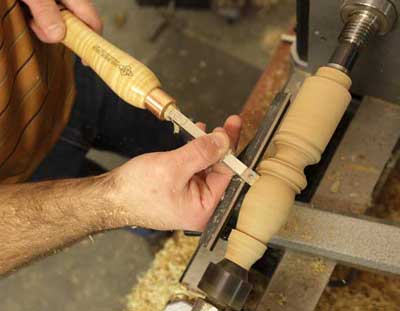
With more than 62,000 hours of machinist experience under his belt, Craig Jackson – inventor of the Ci series of woodturning tools and founder of Easy Wood Tools – has more than a basic understanding of cutting edges. Actually, he’s a master at them.
And so, when a book on segmented bowls sparked his interest in woodturning back in 2004, he figured he’d have a pretty easy time learning how to use conventional high-speed steel lathe tools. He bought all the usual gouges and sharpening wheels, studied the bevel-riding techniques for creating cuts and, of course, began the constant routine of sharpening them. But turning those first chunks of green wood into pretty bowls proved to be more difficult and frustrating than he imagined it would be. For Craig the machinist, the problems stemmed from the tools.
“The way we turners present positive cutting edges to wood with handheld tools is just asking for scary catches and trouble. That, combined with all the complex geometries involved with sharpening the various edges just made me wonder, how do beginning turners make all of this work? There were too many variables for me that take away from the enjoyment of woodturning,” says Craig.
That’s when Craig’s machinist instincts took over and he started to experiment with what he hoped would be a better solution to lathe tools – an easier overall approach. But, it was destined to be an unconventional one. “When I look at a problem that’s tough to solve, I tend to flip it upside down and look at it from a whole new angle.”
Starting with the cutting edge, Craig rejected high-speed steel and settled on carbide, which he says holds an edge 30 to 100 longer. But, instead of outfitting his roughing and finishing tools with a solid bar of carbide, Craig fits just the tips with replaceable carbide inserts – similar to the insert cutterheads on some of today’s new joiners and planers. His Easy Rougher tools feature a square insert with four sharp edges; the Easy Finisher tools have a circular insert with a sharp edge all around.
“In metalworking, when you’re removing mass amounts of material, you use replaceable carbide inserts. A lot of what we do in woodturning is mass wood removal, so inserts just made sense to me,” Craig recalls.
Carbide inserts not only provide a good compromise between sharpness and edge retention, but they also make routine sharpening a thing of the past. When the edge dulls, there’s no trip to the grinder; you loosen an Allen screw, turn the insert to a fresh edge, and continue turning. When the insert is finally dull all around, you replace it. Craig says a single insert on his tools will save the average turner about 120 trips to the grinder for touch-up sharpening. That translates to more time spent turning. And, because there’s no routine sharpening, there’s no chance of altering the important edge geometry that could reduce cutting effectiveness.
However, sharpening was only part of the roadblock to easier turning. The other issue was tool handling. With conventional turning tools, a gouge requires a different style of presentation to the wood than, say, a scraper or parting tool. For Craig, learning all the nuances of tool handling takes time and makes turning harder to learn for beginners. Those demands can even make certain lathe tools impossible to use for people with disabilities.
That’s why Craig designs his Rougher and Finisher tools with square-profile tool shafts instead of fluted, curved bars. It reduces tool presentation to only one style of handling: flat on the tool-rest and level to the floor, regardless of the type of cut being made.
“This geometry is designed to provide support directly beneath the cutting edge, which transfers the cutting pressure downward into the lathe for unmatched tool stability…that translates to easier use for all skill levels.” It also simplifies the learning curve. “If you ask the turners who are using our tools how to make them work, I’ll bet 99 percent of them will tell you the same thing: flat on the tool-rest and level to the floor. You won’t get 99 different answers,” Craig says.
Craig’s novel approach to lathe tools is steadily catching on. Although the company has only been in business a few years, response within the woodworking community has been very favorable, and nearly 100 retailers are now carrying his line of six different tool models. “I thought traditional woodturners would reject our tools, but by and large, they’ve embraced them. We’ve sold more than 7,000 tools so far, and I can count on one hand the number of complaints we’ve had. Only one tool has ever been returned.”
With that success, Easy Wood Tool’s product line continues to grow. The company recently released two new Mini Rougher and Finisher tools using the same insert cutters. A pair of Easy Detailer tools will launch in March, featuring diamond-shaped carbide cutters. And, Craig hopes to develop a full line of hollowing tools in the future – but only if they prove to be easier to use than others on the market. “If it’s not simple, it’s not a solution to me,” he admits.
Craig is proud to say that Easy Wood Tools are made in America. Initially, some components were sourced to other suppliers, but they will soon be made entirely in his factory in Owensboro, Kentucky, with the exception of the carbide cutters. Those are manufactured and ground by three high quality suppliers to Jackson’s proprietary specifications.
He’s also happy to report that Easy Wood Tools will be one of the sponsors of the first-ever Disabled Woodturning Symposium, entitled “Your Time to Turn.” It is slated for November 2010 in Houston, Texas. “We’ll be there to supply as many tools as needed and to have some of our customers help people learn how to turn. We want to do whatever we can to help make woodturning more accessible for everyone.”











